The Coleraine
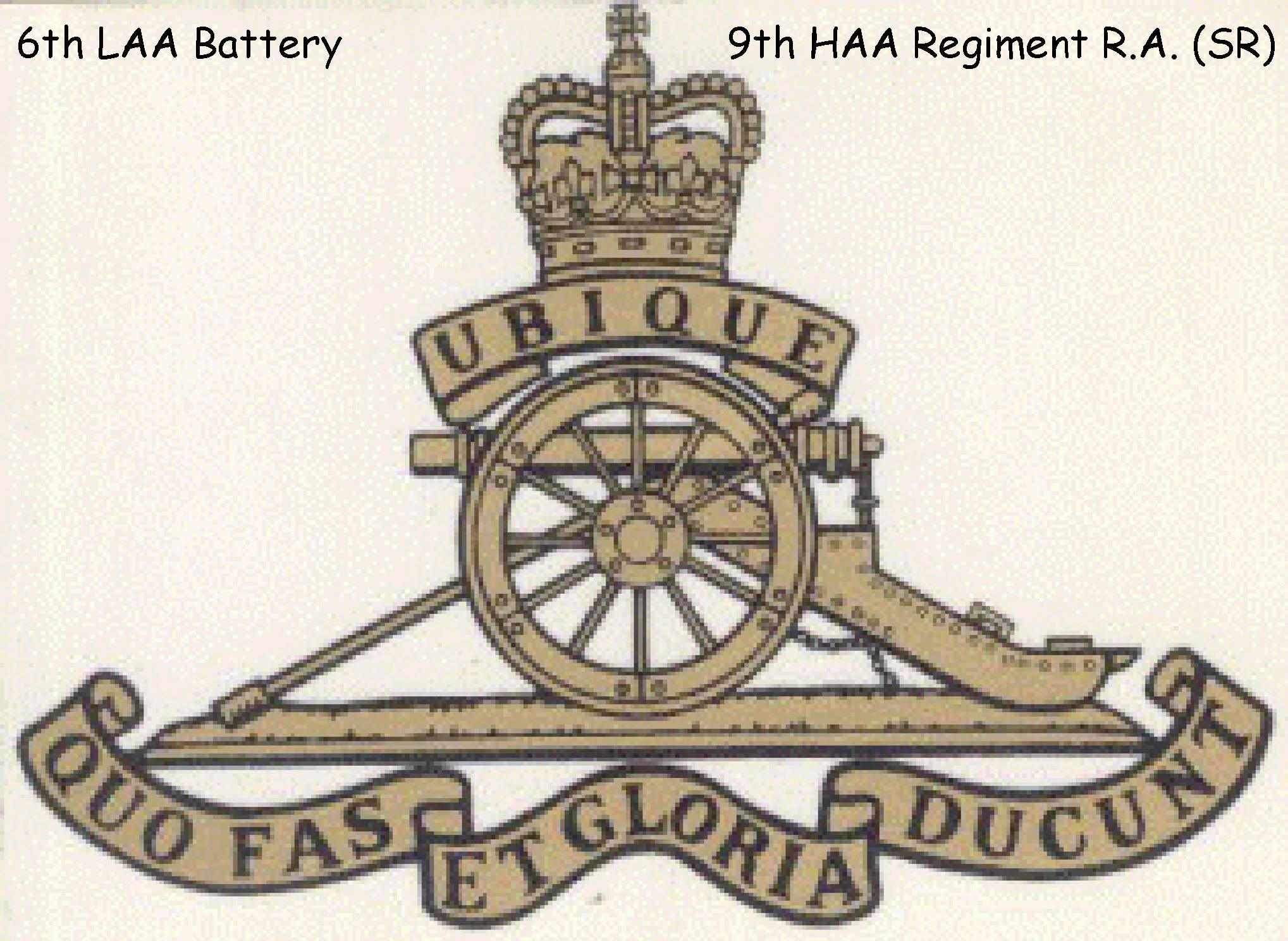
"Everywhere"
“Wherever Duty Takes Us, Glory Follows”
Except for otherwise stated, all the material on this site, "The Coleraine Battery" is the copyright (c) 2004 property of 6 LAA Battery OCA
If you have any material, photos or information on The Coleraine Battery and would like to see it reproduced on this site, please contact me.
Introduction
This is the social history of The Coleraine Battery. The material used in this project has five main sources. The majority of this work is based on the testimonies of the Battery veteran's. I have also used War Diaries, newspaper articles, veteran photo collections and finally, Richard Doherty's book on the history of the 9th (Londonderry) Heavy Anti Aircraft Regiment, "Wall of Steel".
My father, William Gamble and my uncle Thomas Gamble served in the Battery. They did not talk about their wartime experiences and this intrigued me. But there are other reasons why I undertook to research into the history of the Coleraine Battery.
In 1939, almost 200 men from the Coleraine and Mid Ulster areas left their homes, families and safe employment. For the next six years they fought and died with honour in Scotland, Egypt, Cyrenaica (Libya), France, Belgium, Italy, Greece, Holland and Germany. When WWII was over and their unit disbanded, the veterans returned home and they went on with their lives. They did not ask for favours or expect the world to owe them anything. I wanted to know what motivated these men.
My interest has also been fostered by the underlying current of 'esprit de corps ' I have detected between the veterans when I listen to them talk about their experiences. In over twenty-seven years of military service, I have never seen this extremely high degree of honour, pride and affection equalled.
Speedy Moore, a Battery veteran, author and newspaper columnist has also helped to maintain my interest in the Battery with his frequent write ups and sadly, his obituaries to his old comrades.
The Photographic Records "Capt. John Siderfin was the Battery Quarter Master and Official Photographer. He did have a great selection of photographs. All the photographs were placed in a trunk and then loaded on the boat at Alexandria for the return trip to the UK in 1943. En route, this trunk disappeared and every official photograph of the Battery at war in the Western Desert disappeared". Robin Martin (2004)
Even so, some of the Battery personnel did have their own cameras (Box Brownies). Every time a parcel came from home it contained rolls of film for the unofficial photographers. Rolls of film were also available in the Cairo shops. This story will present a photographic record of the Battery at war gleaned from the unofficial photographs.

How Did It All Start?
In 1938, there was the threat of a war between Great Britain and Germany. With the expansion of Germany continuing at an alarming rate, the British government had to consider the use of force against Germany. The main threat was the German method of attack, the 'Blitzkrieg'. This started off with a devastating air attack from the German Luftwaffe.
By January 1938, the British Government had formulated their contingency plans to counter the Blitzkrieg attack. Their next step was to recruit and train the personnel who would deal with these attacks, the Anti Aircraft Units.
Conscription
Britain was not ready for this war. In 1938 British Army strength was only 220,000. Almost fifty percent of this total included units that were serving overseas. (Stanhope, 1979) In order to boost the Army strength and deal with the German threat, conscription had to be enforced in May 1939. Despite the urgency of the task, conscription was not used in Northern Ireland. The province presented a problem when it came to recruiting or conscripting individuals to fight against the Axis powers. This problem is best summed up by Churchill’s statement in May 1941. He had to concede in Parliament that the imposition of conscription on N Ireland was “more trouble than it was worth.”
The source of the “trouble” was Irish Nationalism. During these early months of 1939, the Roman Catholic Clergy and Irish Nationalist leaders held meetings throughout N Ireland to discuss conscription. They saw compulsory military service as a degradation of their Nationalist ideals. Conscription, they proposed, would have to be aggressively opposed by all Nationalists. By July 1939 there had been over 120 Irish terrorist outrages since January. This included fatal bombings and shootings in both N Ireland and Great Britain. In order to cope with the terrorist campaign the Royal Ulster Constabulary and the Special Constabulary establishments had to be increased to 3,000 and 11,000 respectively. The N Ireland government also continued to recruit volunteers for the Home Guard, Air Raid Precaution Officers and service in the British Forces.
From the onset of recruiting in N. Ireland there was a negative mind set in the attitudes of all citizens. This was encouraged, not just by Nationalist leaders, but also by those who had lost relatives in the carnage of the First World War. The Battery personnel expected to be killed early in the war. That had been the fate of many of their relatives in the First World War. For example, at the Battle of the Somme on July 1st 1916, 5553 Ulster Division officers and men were either killed or injured in the first 48 hours. In 1939 there were thousands of young Irishmen living and working in England. These individuals had no intention of either serving or being conscripted into the British Forces. After the declaration of war in 1939 there was an exodus of these young Irishmen from Great Britain back to Ireland. The returning groups became known derisively as the ‘Suitcase Brigades’.
Despite this negative mindset, 80,000 volunteers from Southern Ireland and 38,000 volunteers from Northern Ireland enrolled into the British Armed Forces. Over 4,500 of the Northern Ireland volunteers were killed in action during WWII. (Adamson, in Marrinan 1986)
The Supplementary Reserve (SR)
The Coleraine Battery volunteers were not classed as either Territorial or Regular soldiers. The Battery were classed as a Militia and belonged to the Supplementary Reserve section of the British Army. The standing army of Great Britain always relied upon civilian volunteers to supplement their numbers during periods of domestic disorder and external threat. The earliest volunteers were classed as militia. The history of the militia can be traced back to 1558 and even further. In the early 1900's, Great Britain phased out the Militias and introduced the Territorial Army and Special Reserves on 1st April 1908.
6 Light Anti Aircraft Battery, Royal Artillery, was a Supplementary Reserve of personnel drawn from North Londonderry and Mid Ulster districts. This included the Coleraine, Portrush, Portstewart, Castlerock, Bushmills, Maghera, Upperlands, Tobermore and Kilrea areas. In recognition of their volunteer status, the Militia Medal was awarded to all Battery members.
Recruiting
Officers On January 14th 1939 the local weekly newspaper, the Coleraine Chronicle, reported on the local recruiting drive for Light Anti Aircraft (LAA) officers. Colonel LGS Smith MC OBE and his team had interviewed the candidates for commissions in Coleraine Town Hall on Tuesday 10th January. The newspaper also reported that negotiations were in progress for the purchase of a site for the building of a Drill Hall and Training Camp.
Province wide, the British Army needed 600 officers for the 3rd AA Brigade (SR). There were over 3,000 applicants for the posts, as well as applications from others who wanted to join the ranks.
Robin Martin was amongst the first volunteers into the Battery. He joined early in February 1939 at the age of 26.

Sgt Robin Martin recalled that in February 1939, his initial training in AA tactics took place in The Boathouse on the banks of the River Bann. Fellow trainees included Jack Christie and Robin Wray. Both these men were local solicitors and they would soon lead the Battery as officers.
Other Ranks In N Ireland, conscription was circumvented. In some instances, potential volunteers were approached by their local GP’s or community leaders. These dignitaries introduced the potential volunteers to British Army Officers who went on to explain the immanent threat of war and asked for their commitment. All recruits were left in no doubt that their unit would be a Supplementary Reserve. If the British Army were to be mobilised, then the Coleraine Battery would be called up.
On April 1st 1939, formal recruiting started in Coleraine for the 6th LAA Battery. The recruiting was conducted from offices in the Court House and New Row. The site for the Coleraine Battery was located on the Bushmills Road. At this stage the wooden buildings, including the Drill Hall, were still under construction.

By that first week in April all the officers had been gazetted. This included Captain JG Siderfin, Lt DJ Christie, Lt JL Baxter, Lt L Butler (Portrush), Lt. R Wray (Portrush), Lt. B Clarke (Upperlands) and finally, Lt. RWM Pollock.
Within the first week of recruitment, there were over 160 successful enlistments. Over thirty of these recruits came from the Upperlands district. There was a requirement for a further 40 recruits to complete the establishment.
On the 29th April 1939, the National Service Committee reported that the Coleraine Battery was up to establishment strength. Recruiting had been such a success, an application ha been placed to increase the strength of the unit. Also on this date Compulsory Conscription for 20 – 21 year olds was enforced in Great Britain.
At the end of April the Drill Hall had been built and two Bofors guns were delivered.
“I can remember the day that I enlisted; I was inside the Tamlaght o’ Crilly Orange Hall listening to a speech about “The Royal Artillery” after which there was an approach to those interested in joining up. I penned my name along with others. That was on the 18th April 1939.
Our training started in the Depot in Coleraine on 5th September 1939. This was on Tuesdays and Fridays from 6pm until 9pm each evening. I met Frankie Walls during this period and we trained together throughout the whole period at Coleraine”. (John Kelso)
Kit Issues The Battery had been training for many months before they were issued with a full kit. Their initial training kit was a pair of coveralls and a pair of boots.

Davy Pringle
The Bofors Gun
The fighting weapon of the Coleraine Battery was the 40mm Bofors gun. This gun was developed in the late 1920's by a Swedish firm called Bofors. From the 1920's until WWII, the speed of fighter aircraft had doubled and it was noted that the Bofors gun was capable of meeting this new challenge.
In 1937 the British bought a number of these guns along with 500,000 rounds of ammunition. This initial purchase from the parent company allowed them to negotiate a further deal whereby Great Britain and Canada could manufacture and modify the gun for themselves.
During 1940, under the Land Lease Programme, the US were also manufacturing and deploying the Bofors. (Semmens)
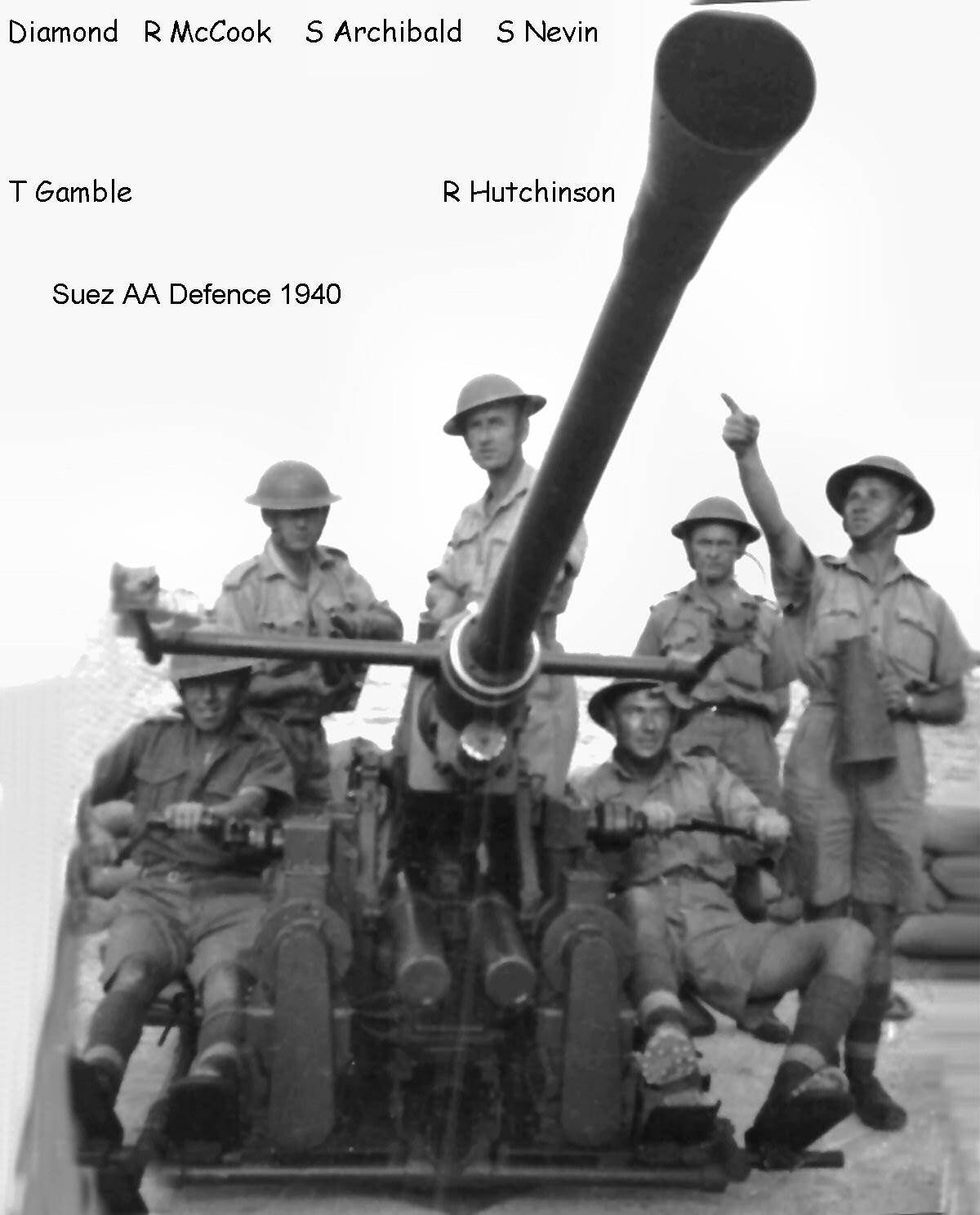
The Gun Crew
Seven personnel manned each gun. This included the Sergeant and two junior Non Commissioned Officers and four gunners. At least two of the gunners were also required to be qualified Heavy Goods Vehicle (HGV) drivers.
|
No. |
Task |
Rank |
|
1 |
Gun Commander (DC) |
Sergeant |
|
2 |
Gun Layer (Line) |
Bombardier |
|
3 |
Gun Trainer (Elevation) |
Lance/Bombardier |
|
4 |
Gun Loader & Firer |
Gunner/HGV Driver |
|
5 |
Ammunition Supply |
Gunner/HGV Driver |
|
6 |
Ammunition Supply |
Gunner |
|
7 |
Target Spotter |
Gunner |
Operating System In the early days, the Bofors gun was either air or water-cooled. It was 8.5 Meters long from muzzle to tow bar and approximately 2.5 Meters wide.
The gun was recoil operated with a sliding breechblock mechanism. Clips of four rounds were fed into the gun through an opening on top of the breechblock. Pulling back on a lever attached to the side of the breech casing allowed the breech block to slide back and one round was pushed into the feed tray by the feed pawls.
Returning the lever to the forward locked position loaded the round and returned the breechblock to the closed position. The gun was now ready to fire, automatically firing each round that had been loaded.
After each round was fired, the expended case was ejected to the rear of the breechblock. Once clear of the breechblock the case was channelled into a trough where its impetus carried the case to the front of the gun.
The Bofors gun was capable of firing at a rate of 120 rounds per minute. The shell itself was 40mm wide, 70mm long and weighed nearly 1 kilo. Because of the weight, the Coleraine gunners called the gun, the 2 Pounder. The destructive power of this shell was equivalent to a hand grenade. Depending on the operational deployment of the gun, the shell used was either, Armoured Piercing, Tracer or Impact High Explosive.
"When the Bofors was first introduced to the Battery, the No 3 (Elevation) fired the gun. This routine was changed in order to conserve ammunition and the barrel of the gun. No 4, the Gun Loader took over this task by firing the gun with the use of a foot lever. That way a person who did not have a sighting picture of the target became responsible for firing the gun". Robin Martin (2004)
Tactical Use The gun was an efficient anti-aircraft weapon designed to independently engage aircraft flying below 2,000 feet that were moving at 300 miles per hour. As an Anti Aircraft weapon it was also used in a tactic called the Umbrella Barrage. This tactic will be described in more detail later on.
As a surface to surface weapon, in it's ground fire role, one gun was capable of throwing the equivalent of 120 hand grenades every minute at a target over 4000 yards away. In the ground fire role the Bofors was used in at least three different ways. It was used either as an Anti Tank weapon, an Anti Personnel weapon or as a Path Marker.
As an anti-tank weapon the 40mm Bofors was of limited use. It was no match for the armour of the Panzer tank.
It was often used as an anti-personnel weapon. For example, William Gamble recalled that he fired the weapon at either retreating or attacking German convoys in both Europe and Egypt. As another example, Lt Martin Jackson of the Coleraine Battery won the Military Cross for employing his guns in a ground role on November 23rd 1941.
In this action Lt Jackson acted as an observer in order to engage four Italian guns that had the Troop and other Force ‘E’ units pinned down. This Italian group consisted of two 47mm guns and two 20mm guns. Sgt Albert Curry's second burst of fire hit one of the 47mm guns. All the Italian gun crews then surrendered (Doherty p185). What is remarkable about this incident was the fact that both men carried it out in full view of the enemy. Lt Jackson was awarded the military Cross and Sgt Curry was awarded a Mentioned in Despatches for their heroism.

Photo supplied by Scot Cousley
As an anti-personnel weapon, the Bofors were also used in a rear guard action at Consthum on the 17/18th December 1944 (Elstob 2003 p160). In this situation, the guns were used to stop the advance of German infantry.
Despite these successes, the ground role limited the life expectancy of the gun itself. It was designed for short bursts at infrequent and fleeting targets. Sustained fire would have led to the gun overheating and having mechanical malfunctions.
Finally, the Bofors round was used as a path marker. Tracer fire from the Bofors Gun was used in Egypt to indicate the direction of travel for troops advancing to engage the German Forces. It was also used the same way in Europe to indicate the targets for the rocket firing Typhoon planes.
The gun was also very popular with the Germans. There were many occasions when captured guns were turned on the Allied Forces.
The Gun Tractor and Bofors Gun
In its Mobile Operational role the Bofors gun was towed by a Gun Tractor. This tractor also carried the gun crew, their kit and equipment as well as the ammunition for the gun. The Troop rations, water supplies and other stores were carried on other Heavy Goods Vehicles.
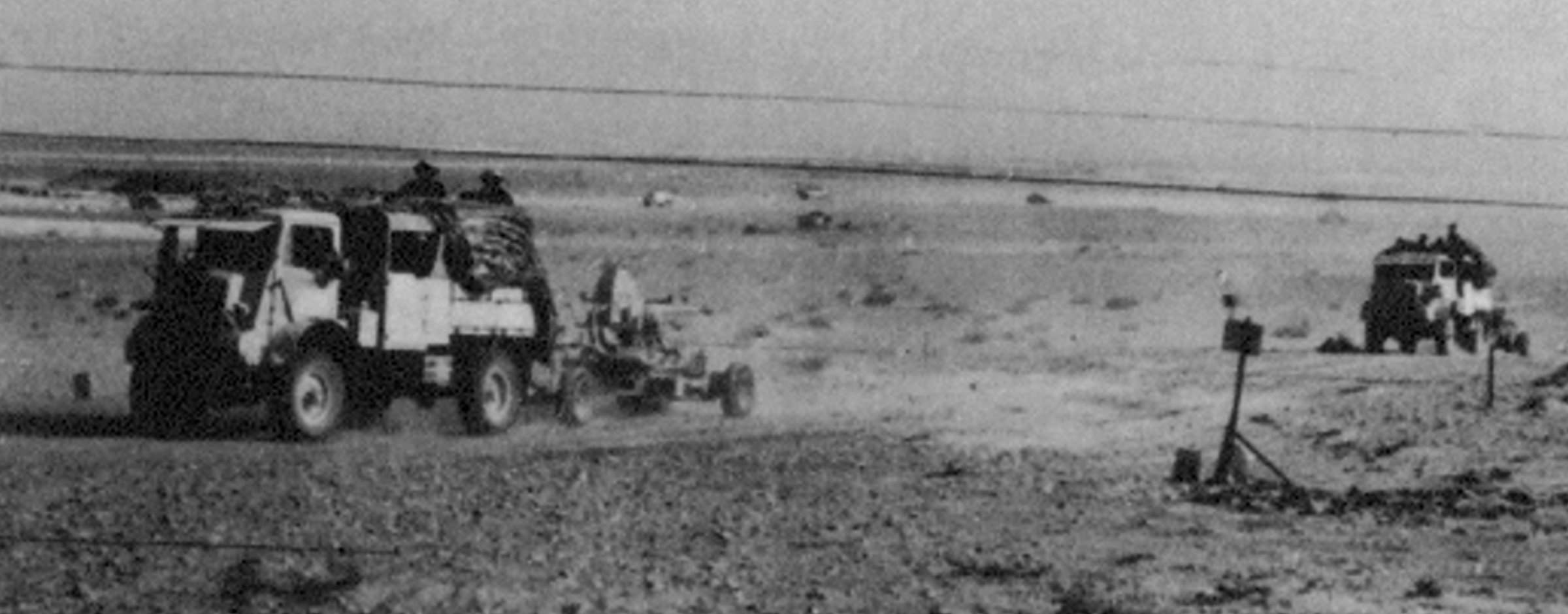
The Self Propelled (SP) Vehicle For the European phase of The Battery operations between 1944 and 1945, some of the Troops were deployed on Self Propelled (SP) vehicles. Here the gun and equipment were mounted on a Morris truck chassis.

Training
The training and administration of the SR was the responsibility of a small cadre of Regular Army personnel. This included Battery Sergeant Major ‘Busty’ Streeter and three Permanent Staff Instructors (PSI's). This cadre was led by Major WW ‘Toby’ Allison (RA), an officer with Anti Aircraft experience. He had been in Active Service in WWI, India and Egypt.

The recruits were expected to complete forty drill nights and fifteen days annual camp each year. The Annual Camp was to be held near Morcambe, Lancashire each September. Attendance at this camp would entitle the gunners to full army pay and a Marriage Allowance.
Provided each gunner attended the mandatory number of training nights and Annual camp, he would be entitled to an Annual Bounty of £9.50.
“Sgt Alexander was one of our Permanent Staff Instructors (PSI's). He was there from the time the Battery was formed. When the Battery was posted to the Middle East Forces he went to OCTU and the last time we learned about it, he was a Captain”. Robin Martin (2005)
With the exception of Major WW Allison and Sgt. Alexander, the remainder of the Staff remained with the Battery for the full period of the war.


X, Y and Z Troop The Battery volunteers were posted to their designated Troops before training commenced. X Troop consisted of men from the Coleraine area. Y Troop consisted of men from the outlying districts of Portstewart, Portrush, Castlerock and Garvagh. This Troop was augmented with the over-spill from X Troop.
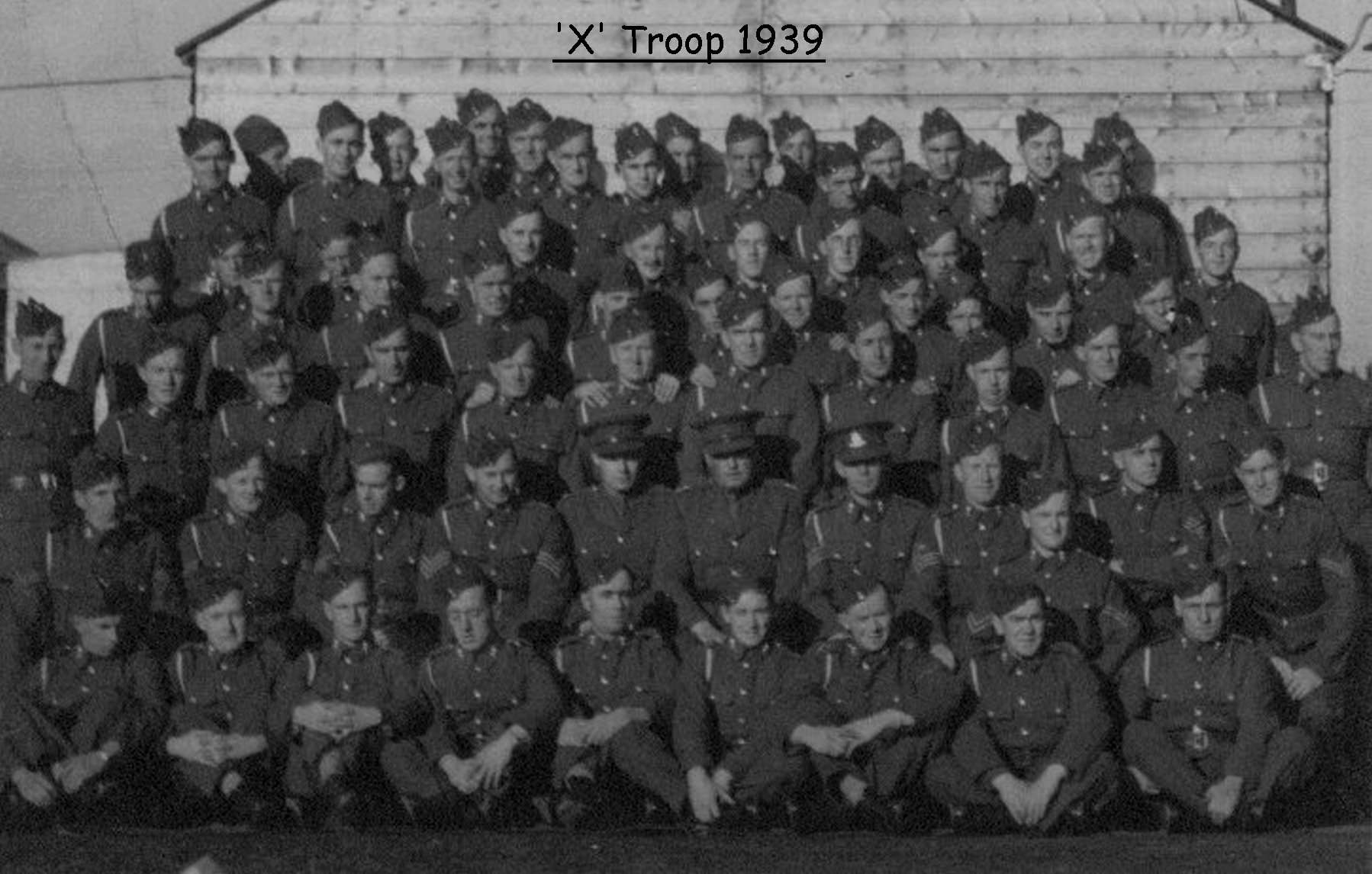
Z Troop consisted of men from the Mid Ulster area including Kilrea, Upperlands, Tobermore and Maghera. Again, there were many Coleraine men in Z Troop for the duration of the war. This included Robbie Boyce and Jackie Pearson. The Troop Commander’s Batman for the first year was William “Speedy” Moore.
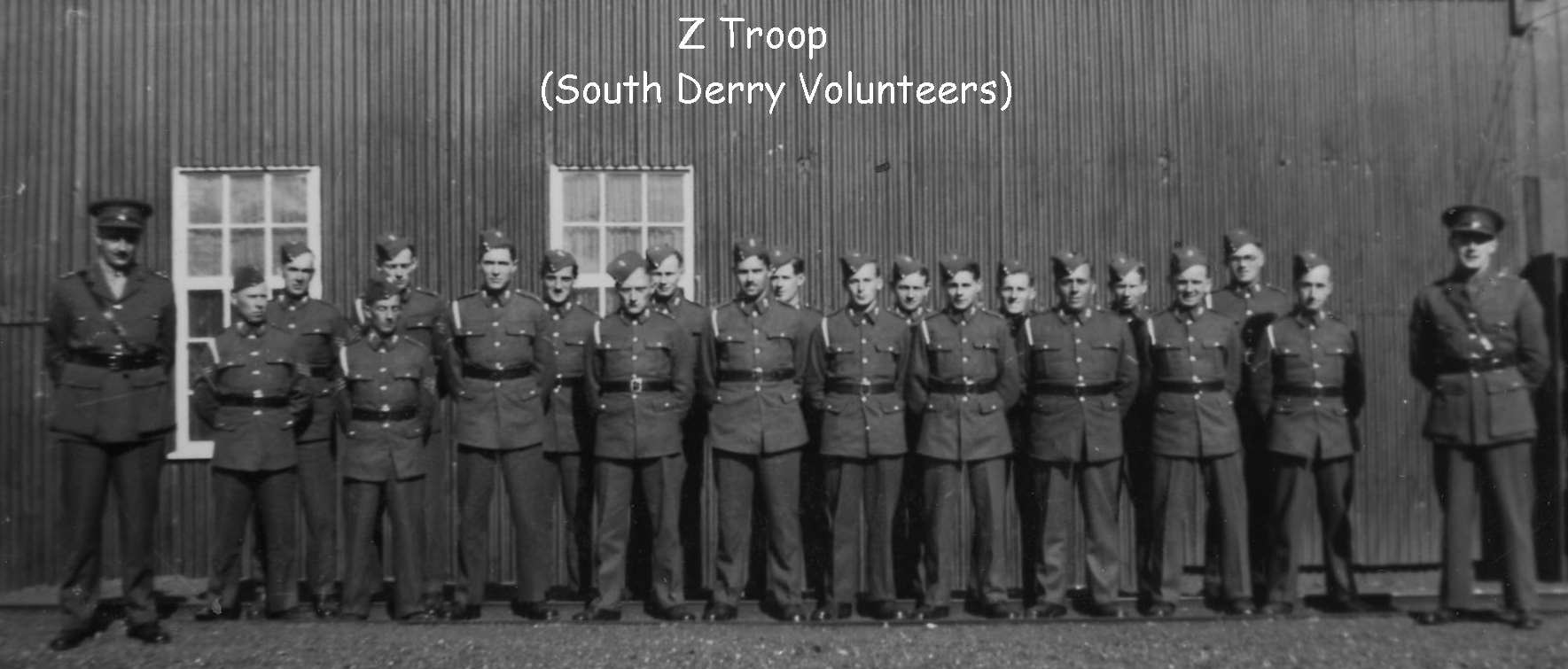
X and Y Troops trained on separate nights through the week after their normal days work. Special provisions had to be made for Z Troop. Because of the distance they had to travel, training in the evening was not possible. Initially, they trained at the week ends.
Training included Foot Drill, Rifle Drill, Bofors Drill, Route Marching as well as Vehicle, Gun and Personal Kit maintenance. The training the Battery received from the RA Staff was of such a high order that visitors to the Calf Lane Camp mistook the volunteers for experienced regular soldiers.

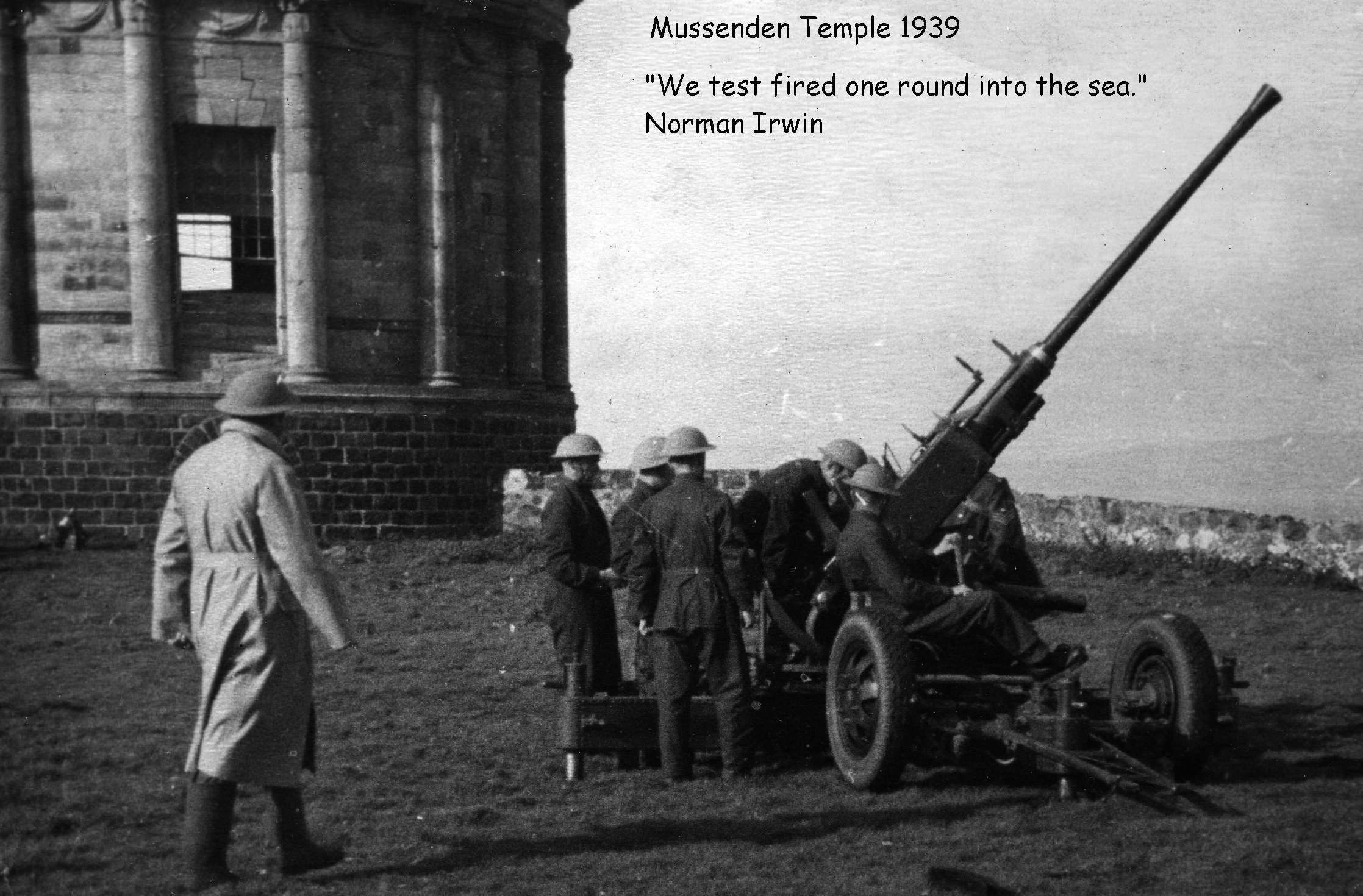
3 Anti Aircraft Brigade (SR)
Brigade Structure 3 Brigade consisted of one Searchlight Regiment, two AA Regiments, a Signals Section and a workshop of the Royal Army Ordnance Corps. The Coleraine Battery was a unit within the 9th (Londonderry) Anti-Aircraft Regiment. Outlined below are details on the formation and location of all the Royal Artillery units in Northern Ireland in 1939 (D.A. Ryan). The heavy anti aircraft batteries were equipped with 3.7 inch guns and the light anti aircraft batteries were equipped with the Bofors 40mm gun (N Irwin 2004).
|
Regiment |
Battery |
Location |
|
3rd (Ulster) Searchlight Regiment |
HQ, 10, 11 Btys. |
Belfast |
|
|
9 Bty |
Clonaver, Strandtown |
|
|
12 Bty |
Lurgan |
|
8th (Belfast) Anti-Aircraft Regiment |
HQ, 21, 22, 23 Btys |
Belfast |
|
|
5 Light AA Bty |
Newtonards |
|
9th (Londonderry) Anti-Aircraft Regiment |
HQ, 24 & 25 Btys |
Londonderry |
|
|
26 AA Bty |
Ballymena |
|
|
6 Light AA Bty |
Coleraine |
|
102nd Anti-Aircraft Regiment |
HQ, 314, 315 & 316 Btys |
Antrim |
|
|
175 & 176 Light AA Btys |
Antrim |
Light Anti Aircraft Regiment Structure
The following table outlines the typical structure of a Light Anti-Aircraft Regiment and Batteries in the Royal Artillery. At its peak strength, The Coleraine Battery consisted of approximately 250 men. The Battery was split into Three Troops with four guns in each Troop. Each Gun was manned by seven personnel.
|
Regimental Head Quarters |
||||||||
|
1 Battery |
2 Battery |
3 Battery |
||||||
|
Battery HQ |
Battery HQ |
Battery HQ |
||||||
|
A Troop |
B Troop |
C Troop |
D Troop |
E Troop |
F Troop |
X Troop |
Y Troop |
Z Troop |
|
Guns (4) |
Guns (4) |
Guns (4) |
Guns (4) |
Guns (4) |
Guns (4) |
Guns (4) |
Guns (4) |
Guns (4) |
1939 Weddings
On 3rd September 1939 war was declared and all Battery personnel received their call up papers. They were asked to report to the Drill Hall at calf Lane Camp.
Research on Battery personnel has shown that many of them married at this time.
It was stated by one Battery individual that, well before the war started, their knowledge of warfare was gleaned from the local cinema screenings of the First World War, as well as their own family history. He expected to be killed in the early stages of the war.
The numbers of Ulster volunteers for WWII service reflected the sacrifices made by their forefathers. At least 75,000 volunteered for WWI and only 38,000 for WWII. The Battery personnel all married their sweethearts because they wanted to provide for them through a widows pension.

The Legal System
In October 1939 Blackout Regulations and Food Rationing started in Northern Ireland. For the duration of the war the Rationing and Blackout Regulations were strictly enforced. A new class of criminal started to go through the portals of Coleraine Courthouse on the Castlerock Road.
The prosecutions included; Café Owners who ‘Failed to keep a written record of all meals sold on their premises’, Poultry owners who ‘Sold eggs to a person not authorised to collect eggs’, Car owners who ‘Misused their petrol ration instead of using public transport’.
Family Ties
The Battery had twenty three pairs of brothers and four sets of three brothers. These were the Diamonds, Dohertys, Simpsons and McDonalds.
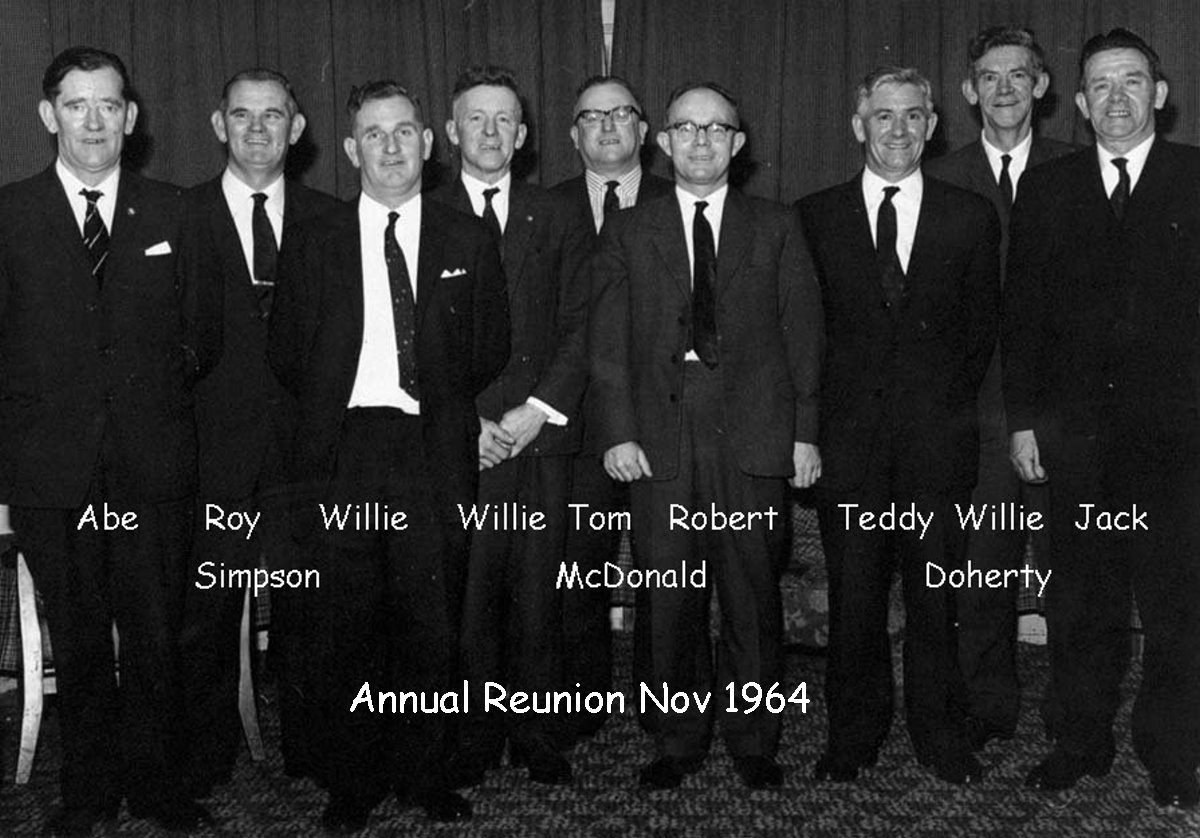
Farewells to Coleraine
The Battery officers and men (200) were entertained in the Town Hall as guests of Coleraine Rotary Club on Friday 27th October. Music was supplied by 2nd Coleraine Company Boys Brigade Silver Band. Twelve of that band had joined the Battery. The Battery men were also entertained by a veteran of the Somme, Jim Baxter. He was a noted flautist and a former member of the 10th Iniskilling Fusiliers. The Battery applauded him when he played the marches of the Ulster Division.
The evening’s entertainment concluded with community singing. A fitting conclusion considering the fact that quite a few of Killowen Male Voice Choir were now in the Battery. The songs included hits from the First World War, “Tipperary” and new hits such as, “Hang out the washing on the Siegfried Line”. This song had been written by the Portstewart resident who also penned the hit, “Red Sails in the Sunset”, Jimmy Kennedy. Little did the Battery members know that two English officers attached to the Battery Lt. Brennan and Lt Bridgland, would be killed in Action at the Siegfried Line in 1944.
In his speech, Mr AD Sutherland, the President of the Rotary Club talked about how the citizens of Coleraine admired the way the volunteers had conducted themselves during training.
He went on to advise the Battery to keep all their data and compile a dossier on all the interesting episodes and incidents. It was his hope that some budding author would write the Battery history. “Such a history would be of very special interest to coming generations of Coleraine people”.
In his response, Major WW Allison went on to say that as an Englishman he was the proudest man in Ireland. He had never before experienced a finer spirit, a finer enthusiasm and a finer sense of loyalty that was to be found in the Battery. He had absolute confidence that the Battery would never be anything but a cause of pride to Coleraine.
The following week, on Friday 3rd November, the Battery officers and men were back in the Town Hall. This time they were the guests of Alderman DH Christie. The Alderman’s son, Lt. DJ Christie, would go on to be the Officer Commanding the Battery.
The final farewell for the Battery was conducted at the Strand Hotel in Portstewart.

On 28th November 1939, the Battery marched through their town on the way to Coleraine Railway Station. They sang as they marched. Many who watched that parade recalled a similar march twenty five years before when the 10th Battalion Royal Iniskilling Fusiliers set off from Coleraine to Finner Camp in the autumn of 1914.
The Battery was heading for Scotland. There, under the command of the 51st LAA Regiment, they covered AA Defences over a wide area.
Coleraine Battery Deployment for World War II
|
Date |
Deployment/Attachment |
Location |
|
Sept '39 |
X, Y and Z Troop 6th LAA Battery 9th (Londonderry) Heavy AA Rgt |
Coleraine |
|
Nov '39 |
Small Arms Defence of Key Locations |
Rosyth, Aberdeen, Grangemouth |
|
Aug '40 |
Cark Camp - LAA Practice |
Lancashire |
|
Aug '40 |
Minley Camp - LAA Practice |
Farnborough Hampshire |
|
8th Sept' 40 |
SS Dominion Monarch - Liverpool |
En Route to Egypt |
|
Nov '40 until July '41 |
27th Light AA Rgt RA (SR) Western Desert Force - Static AA Defence |
Port Said and the Suez Canal |
|
July 21st '41 |
Reserve - Preparing for Mobile Desert Warfare |
N Africa |
|
Aug '41 - 43 |
Mobile Desert Warfare. Oct '42 Troops renamed A, B, C and D Troop was added. |
8th Army HQ Guard, N Africa |
|
June 44 - 45 |
Ground Fire Roles and LAA Defence of Airfields, Ammunition Dumps, Field Gun Batteries and other Key locations/ 27th LAA Regiment RA (SR) |
NW Europe |